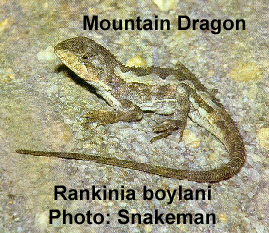 Australian breaches of CITES Treaty.
Australian breaches of CITES Treaty.Victoria on target to get a second extinct species of dragon lizard – State government to blame.
Media release June 2019.
 Australian breaches of CITES Treaty.
Australian breaches of CITES Treaty.
This month a paper published by Australia’s foremost reptile expert, the Snakeman Raymond Hoser has shown that following the recent announcement that the South-Eastern Lined Earless Dragon Lizard Tympanocryptis pinguicolla may be the first species of Lizard to be formally declared extinct in Victoria since European settlement, a second dragon species, namely Rankinia jameswhybrowi has emerged as likely to become extinct in an almost identical set of circumstances.
Hoser has shown that an anti-science doctrine known as “Kaiser et al.” is being recklessly used by Victorian government employees to refuse to recognize the existence of reptile species at risk of extinction until after they actually become extinct.
“Kaiser et al.” and actions by those who follow the doctrine are also in breach of the CITES Treaty, of which Australia and most other countries of the world are ratified parties.
A species of lizard formally discovered and named in 2015 by Hoser has not yet been recognized by government in Victoria even though their own "scientist" has published data showing that the said species diverged from its nearest relative nearly 4 million years ago.
Known as Rankinia jameswhybrowi Hoser, 2015, the species of so-called "Mountain Dragon", is known only from the Big River State Forest in north-east Victoria.
Since the lizard was formally discovered the area it occurs in has been aggressively logged by the State Government (in breach of an election promise) and burnt out by a severe bushfire, meaning that it may already be rare or extinct.
Rankinia jameswhybrowi is restricted in distribution by several factors and nearby areas of suitable habitat are instead home to a similar species Rankinia hoserae, which as already mentioned diverged some 4 MYA.
Scandalously the three named species of Mountain Dragon in Victoria (all shown to be distinct by DNA divergences from one another and three other species from interstate), none of which are particularly common or widespread, are all being effectively ignored by the Victorian government. Instead they are treated by relevant State Government employees as being Rankinia diemensis, a very different and much larger species found only in Tasmania.
Hoser says, “These people know they are lying about the ID of the three relevant species, including the very rare and restricted Rankinia jameswhybrowi … my paper shows that failure by government and their employees to recognize and manage these threatened species will almost certainly lead to one or more further extinctions in the near future. … If this occurs then they must be held accountable and culpable”
Hoser went on to say, “Lovers of wildlife and reptiles in particular, should act to stop this scandalous decline in our native species from occurring.”
Hoser notes a similar situation is also occurring with a species of frog only found in north-east Victoria and nearby New South Wales. Threatened by a fungus killing wild frogs, the species is at very real risk of extinction. The government of Victoria is however treating the local species as being the same as another that is common on the New South Wales central coast. Both are very different and this has also been confirmed by DNA studies.
Australia is also a signed up party to the International Union for the Conservation of Nature (IUCN), in turn bound by the rules of the International Code of Zoological Nomenclature, controlled by the International Commission of Zoological Nomenclature (ICZN). In using the anti-science doctrine known as “Kaiser et al.” to in turn deliberately fail to apply the rules of the International Code of Zoological Nomenclature as dictated by anti-science doctrine known as “Kaiser et al.”, government employees are putting Australia outside of its international wildlife conservation obligations and the government can be penalized as a result.
“Kaiser et al. in the 2013 manifesto and documents published more recently openly call for the effective scrapping of the International Code of Zoological Nomenclature and the authority of the ICZN.
The peer reviewed paper published by Hoser can be obtained in hard copy or online via the website at:
http://www.herp.net.
The citation is:
Hoser, R. T. 2019. Richard Shine et al. (1987), Hinrich Kaiser et al. (2013), Jane Melville et al. (2018 and 2019): Australian Agamids and how rule breakers, liars, thieves, taxonomic vandals and law breaking copyright infringers are causing reptile species to become extinct. Australasian Journal of Herpetology 39:53-63. Published on 12 June 2019.
Further information on Rankinia jameswhybrowi can be found in the original 2015 paper describing the species.
Hoser, R. T. 2015. Australian agamids: Eighteen new species from the genera Amphibolurus Wagler, 1830, Lophognathus Gray, 1842, Rankinia Wells and Wellington, 1984, Diporiphora Gray, 1842, Tympanocryptis Peters, 1863, as well as three new genera and six new subgenera. Australasian Journal of Herpetology 30:37-64. (Published 10 November 2015).
Further information from (Australia): 0412-777-211
Or by visiting
http://www.snakeman.com.au
Non-urgent email inquiries via:
The Snakebusters bookings page.
Urgent inquiries phone:
Melbourne, Victoria, Australia:
(03) 9812 3322 or 0412 777 211